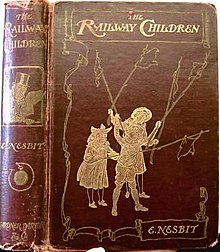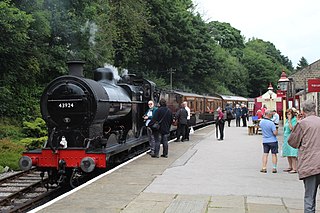
The Keighley & Worth Valley Railway (KWVR) is a 5-mile-long (8 km) heritage railway in the Worth Valley, West Yorkshire, England, which runs from Keighley to Oxenhope. It connects to the National Rail network at Keighley railway station.

Jennifer Ann Agutter is an English actress. She began her career as a child actress in 1964, appearing in East of Sudan, Star!, and two adaptations of The Railway Children; the BBC's 1968 television serial and the 1970 film version. In 1971 she also starred in the critically acclaimed film Walkabout and the TV film The Snow Goose, for which she won an Emmy Award for Outstanding Supporting Actress in a Drama.

The Titfield Thunderbolt is a 1953 British comedy film directed by Charles Crichton and starring Stanley Holloway, Naunton Wayne, George Relph and John Gregson. The screenplay concerns a group of villagers trying to keep their branch line operating after British Railways decided to close it. The film was written by T. E. B. Clarke and was inspired by the restoration of the narrow gauge Talyllyn Railway in Wales, the world's first heritage railway run by volunteers. "Titfield" is an amalgamation of the names Titsey and Limpsfield, two villages in Surrey near Clarke's home at Oxted.
Notable examples of railways in fiction include:
Sally Thomsett is an English actress who starred as Phyllis in the film The Railway Children (1970) and played Jo in the TV sitcom Man About the House (1973–1976). She also appeared as Janice in the film Straw Dogs (1971) and Nemo in Baxter! (1973).
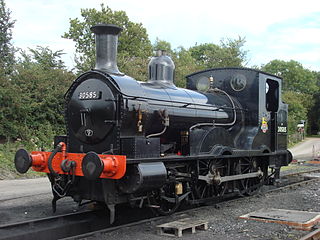
The London and South Western Railway (LSWR) 0298 Class or Beattie Well Tank is a class of British steam locomotive. They are 2-4-0WTs, originally built between 1863 and 1875 for use on passenger services in the suburbs of London, but later used on rural services in South West England. Out of a total production of 85, two locomotives have been preserved, both in operational condition.
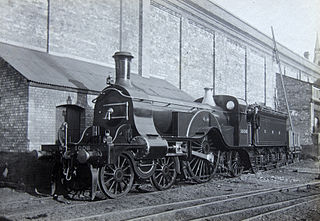
The Great Northern Railway (GNR) No. 1 class Stirling Single is a class of steam locomotive designed for express passenger work. Designed by Patrick Stirling, they are characterised by a single pair of large driving wheels which led to the nickname "eight-footer". Originally the locomotive was designed to haul up to 26 passenger carriages at an average speed of 47 miles per hour (76 km/h). They could reach speeds of up to 85 mph.

The LSWR M7 class is a class of 0-4-4T passenger tank locomotive built between 1897 and 1911. The class was designed by Dugald Drummond for use on the intensive London network of the London and South Western Railway (LSWR), and performed well in such tasks. Because of their utility, 105 were built and the class went through several modifications over five production batches. For this reason there were detail variations such as frame length. Many of the class were fitted with push-pull operation gear that enabled efficient use on branch line duties without the need to change to the other end of its train at the end of a journey.
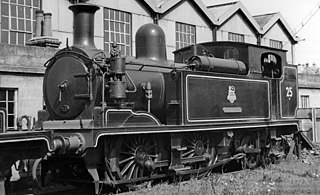
The LSWR O2 class is a class of 0-4-4T steam locomotive designed for the London and South Western Railway by William Adams. Sixty were constructed during the late nineteenth century. They were also the last steam engines to work on the Isle of Wight, with the final two being withdrawn in 1967. One has been preserved and is operational.

Dugald Drummond was a Scottish steam locomotive engineer. He had a career with the North British Railway, LB&SCR, Caledonian Railway and London and South Western Railway. He was the older brother of the engineer Peter Drummond, who often followed Dugald's ideas in his own work.
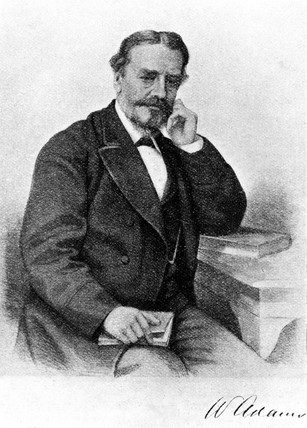
William Adams was an English railway engineer. He was the Locomotive Superintendent of the North London Railway from 1858 to 1873; the Great Eastern Railway from 1873 until 1878 and the London and South Western Railway from then until his retirement in 1895. He is best known for his locomotives featuring the Adams bogie, a device with lateral centring springs to improve high-speed stability. He should not be mistaken for William Bridges Adams (1797–1872) a locomotive engineer who, confusingly, invented the Adams axle – a radial axle that William Adams incorporated in designs for the London and South Western Railway.

Joseph Hamilton Beattie (1808-1871) was a locomotive engineer with the London and South Western Railway. Joseph Beattie was born in Ireland on 12 May 1808. He was educated in Belfast and initially apprenticed to his father, a Derry architect. He moved to England in 1835 to serve as an assistant to Joseph Locke on the Grand Junction Railway and from 1837 on the London and Southampton Railway. After the line opened he became the carriage and wagon superintendent at Nine Elms and succeeded John Viret Gooch as locomotive engineer on 1 July 1850.

The Railway Children is a 1970 British family drama film based on the 1906 novel of the same name by E. Nesbit. The film was directed by Lionel Jeffries and stars Dinah Sheridan, Jenny Agutter, Sally Thomsett, Gary Warren and Bernard Cribbins in leading roles. The film was released to cinemas in the United Kingdom on 21 December 1970.

The LSWR 415 class is a 4-4-2T steam tank locomotive, with the trailing wheels forming the basis of its "Radial Tank" moniker. It was designed by William Adams and introduced in 1882 for service on the London and South Western Railway (LSWR).

Nine Elms Locomotive Works were built in 1839 by the London and South Western Railway (LSWR) adjoining their passenger terminus near the Vauxhall end of Nine Elms Lane, in the district of Nine Elms in the London Borough of Battersea. They were rebuilt in 1841 and remained the principal locomotive carriage and wagon workshops of the railway until closure in stages between 1891 and 1909. Thereafter a large steam motive power depot remained open on the site until 1967, serving Waterloo railway station.

The LSWR T3 class is a class of express passenger 4-4-0 steam locomotives designed for the London and South Western Railway by William Adams. Twenty were constructed between 1892 and 1893. One, No. 563, has been preserved and restored to full working order.
Henry Cyril Casserley was a British railway photographer. His prolific work in the 1920s and 1930s, the result of travelling to remote corners of the railway network in the United Kingdom and Ireland, has provided subsequent generations with a comprehensive source of illustrations for books and magazines.
The Railway Children is a 2000 drama television film based on the 1906 novel by E. Nesbit. It was broadcast for the first time in the United Kingdom on 23 April 2000. Shortly afterwards, it was shown in the United States on the series Masterpiece Theatre.
Damian Cruden was the former artistic director of York Theatre Royal and artistic director designate of the now failed Shakespeare's Rose Theatres. He is currently Artistic Director of Alnwick Playhouse.
The Railway Children Return, known as Railway Children in the US, is a 2022 family drama film directed by Morgan Matthews and written by Danny Brocklehurst. It is a sequel to the 1970 film The Railway Children, itself based on the E. Nesbit novel of the same name. The film stars Jenny Agutter, Sheridan Smith, Tom Courtenay and John Bradley. It was released in the United Kingdom on 15 July 2022 by StudioCanal.
